
Philately is the study of postage stamps and postal history. It also refers to the collection and appreciation of stamps and other philatelic products. While closely associated with stamp collecting and the study of postage, it is possible to be a philatelist without owning any stamps. For instance, the stamps being studied may be very rare or reside only in museums.
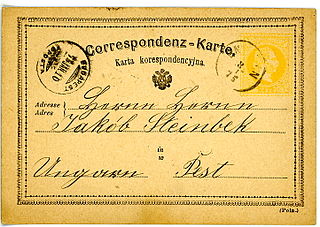
Postal cards are postal stationery with an imprinted stamp or indicium signifying the prepayment of postage. They are sold by postal authorities. On January 26, 1869, Dr. Emanuel Herrmann of Austria described the advantages of a Correspondenz Karte. By October 1, 1869 the world's first postal card was produced by Austria-Hungary. They caught on quickly. By the end of 1870, Great Britain, Finland, Switzerland and Württemberg joined the countries issuing postal cards. In the United States, they were first produced in 1873. Some of the forms taken by postal cards include the regular single card which may be commemorative or definitive, attached message-reply cards, airmail postal cards, and official postal cards used for official government business with a "penalty for private use".

A piece of postal stationery is a stationery item, such as a stamped envelope, letter sheet, postal card, lettercard, aerogram or wrapper, with an imprinted stamp or inscription indicating that a specific rate of postage or related service has been prepaid. It does not, however, include any postcard without a pre-printed stamp, and it is different from freepost for preprinted cards issued by businesses. In general, postal stationery is handled similarly to postage stamps; sold from post offices either at the face value of the printed postage or, more likely, with a surcharge to cover the additional cost of the stationery. It can take the form of an official mail issue produced only for the use of government departments.
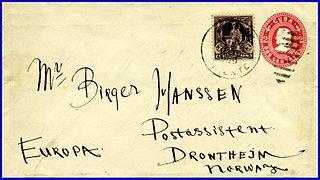
A stamped envelope or postal stationery envelope (PSE) is an envelope with a printed or embossed indicium indicating the prepayment of postage. It is a form of postal stationery.
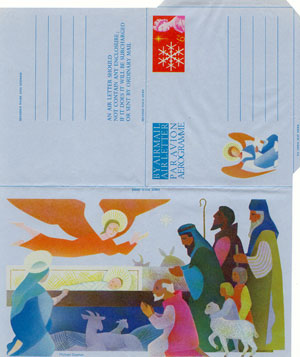
An aerogram, aerogramme, aérogramme, air letter or airletter is a thin lightweight piece of foldable and gummed paper for writing a letter for transit via airmail, in which the letter and envelope are one and the same. Most postal administrations forbid enclosures in these light letters, which are usually sent abroad at a preferential rate. Printed warnings existed to say that an enclosure would cause the mail to go at the higher letter rate.

This is a survey of the postage stamps and postal history of Cuba.
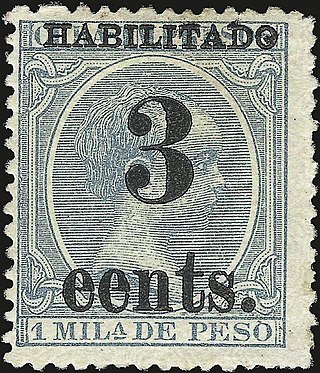
Linn's World Stamp Almanac defines a provisional stamp as "a postage stamp issued for temporary use to meet postal demands until new or regular stocks of stamps can be obtained."
This is a survey of the postage stamps and postal history of Algeria.

A specimen stamp is a postage stamp or postal stationery indicium sent to postmasters and postal administrations so that they are able to identify valid stamps and to avoid forgeries. The usual method of invalidating the stamps is either overprinting in ink or perforating the word Specimen across the stamp and where English is not the common language, the words Muestra (Spanish), Monster (Dutch), Muster (German) or Образец have been used instead.
In philately, the Higgins & Gage World Postal Stationery Catalog is the most recent encyclopedic catalogue of postal stationery covering the whole world. Despite most volumes not having been updated for over thirty years, the catalogue and the H & G numbering system are still widely used by philatelists and stamp dealers although the values given in the catalogue are out of date.

J. Murray Bartels was a New York City-based dealer and auctioneer of rare postage stamps. He was also well known for his knowledge of United States postal stationery.

In philately, an imprinted stamp is a stamp printed onto a piece of postal stationery such as a stamped envelope, postal card, letter sheet, letter card, aerogram or wrapper. The printing may be flat upon the surface of the paper, or embossed with a raised relief. An imprinted stamp is also known as unadhesive stamp or indicium.

In philately, a cut-out is an imprinted stamp cut from an item of postal stationery such as a postal card, letter sheet, aerogramme or wrapper that may have been used as a normal stamp.

This is a survey of the postage stamps and postal history of Gibraltar.
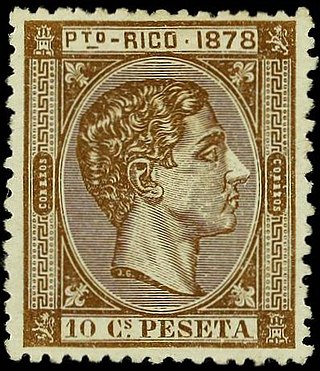
The postal history of Puerto Rico began around 1518, at least for official mail, when Spain adopted general postal regulations; although the first documentation of Spanish postal regulations specific to the Caribbean was 1794. The first postage stamps were issued 168 years ago for Puerto Rico and Cuba in 1856. Postage stamps just for Puerto Rico followed, and later postal cards and telegraph stamps were issued. United States postal administration began in 1899 and the last stamps specifically for Puerto Rico were issued in 1900. They were superseded by U.S. stamps, which are still used today on the island as it remains a territory serviced by the United States Postal Service (USPS).
Knife is the cutting die for envelope or wrapper blanks. It is called a knife rather than a die because the latter is an object that makes an embossed printed impression of the stamp or indicium on the envelope. Traditionally, a knife would normally be made of forged steel. It was placed on a stack of paper with the sharp edge against the paper. The press head forced the cutting edge all the way through the stack of paper. The cut blanks were removed from the knife and the process was repeated. Not only could it cut out the odd shape of an envelope, but a knife could be used to cut out shapes of airmail stickers or gummed labels in the shape of stars or circles. The variety of shapes a knife could cut would be infinite.

In philately a wrapper is a form of postal stationery which pays the cost of the delivery of a newspaper or a periodical. The wrapper is a sheet of paper, large enough to wrap around a folded or rolled newspaper and with an imprinted stamp to pay the cost of postage. Some catalogs and reference books refer to a wrapper as postal bands which comes from the French term bandes postale. Still others refer to it as a newspaper wrapper or periodical wrapper.

The term corner card means the wording, sometimes with a pictorial feature, in the upper left hand corner of a postal stationery envelope or an envelope designed to have regular adhesive stamps affixed to it. It is there for the purpose of stating the sender's return address to facilitate the return of undeliverable mail.

The term earliest reported postmark or ERP is a term used by the United Postal Stationery Society (UPSS) for the past four or more decades. They have established a database in which the earliest postmarks on stamped envelopes or postal card or letter sheets is kept. Postmarks are typically dated from days to many months after the date of issuance. An envelope can come out in varying sizes, colors, or shapes without notification to the public. Collecting the earliest reported postmark for a particular variety is an ongoing effort.